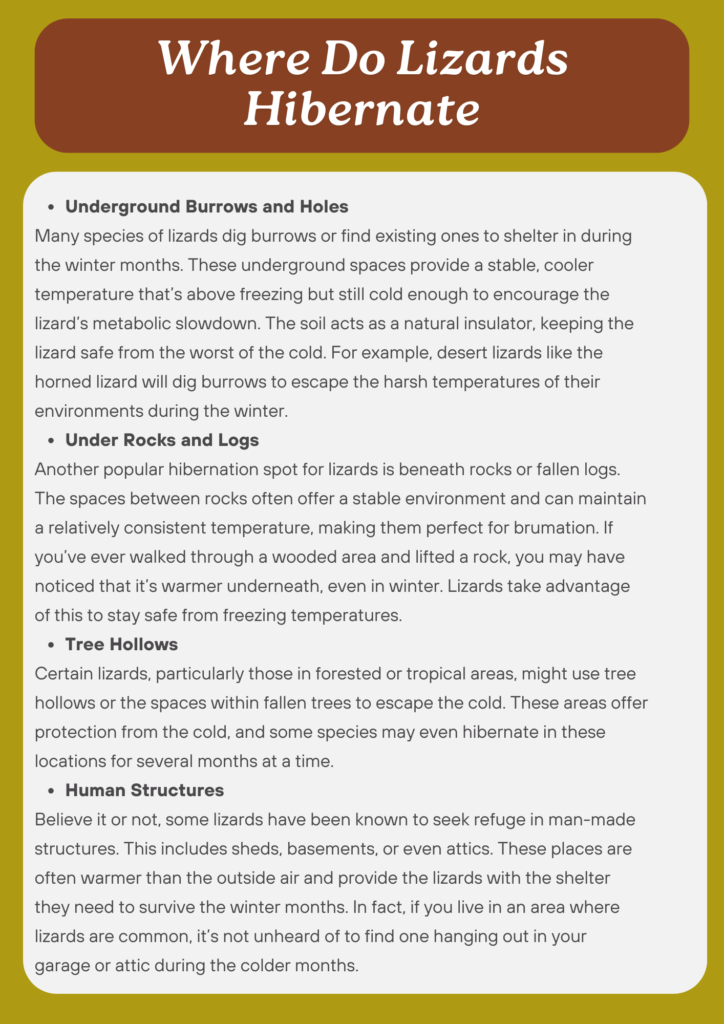Lizards are some of the most fascinating creatures on the planet. These scaly little critters can be found in a variety of environments, from the deserts to the forests, and they’re known for their unique behaviors, like shedding their skin or basking in the sun. One behavior that often gets a lot of attention, especially when colder months roll around, is hibernation. Yep, just like some mammals, lizards hibernate too. But where exactly do they go during this time, and how do they manage to survive without freezing? If you’ve ever wondered where lizards hibernate, this article is for you. Let’s dive into the world of lizards and explore their hibernation habits. It’s a pretty cool subject, I promise!
What is Hibernation for Lizards?
Hibernation, in the context of lizards, isn’t exactly like the deep sleep we usually think of when we talk about bears or bats. Lizards don’t exactly “hibernate” in the same way warm-blooded animals do, but they enter a state of dormancy known as “brumation.” Brumation is similar to hibernation but it’s specific to cold-blooded animals like reptiles. During brumation, lizards’ metabolic rates drop significantly. This means they need less food, and they become much less active. Essentially, they’re in a kind of suspended animation until the temperatures warm up enough for them to be active again.
You know how when the weather gets cold, you want to curl up in a blanket and stay warm? Well, for lizards, the drop in temperature signals the start of brumation. In fact, it’s pretty common for lizards to go through this state during the winter months when the cold makes food scarce, and conditions aren’t ideal for the lizard to be active.
Where Do Lizards Hibernate?
Now, this is the big question – where do these reptiles go when they start their brumation process? Since lizards are cold-blooded, they depend on external heat sources to regulate their body temperature, unlike humans who can generate their own warmth. So, when temperatures drop, lizards will seek out places that are warmer and offer some protection from the cold.

Lizards usually hibernate in burrows, under rocks, or in other protected spaces. These places provide them with some insulation against the extreme cold. Let’s break it down further:
- Underground Burrows and Holes
Many species of lizards dig burrows or find existing ones to shelter in during the winter months. These underground spaces provide a stable, cooler temperature that’s above freezing but still cold enough to encourage the lizard’s metabolic slowdown. The soil acts as a natural insulator, keeping the lizard safe from the worst of the cold. For example, desert lizards like the horned lizard will dig burrows to escape the harsh temperatures of their environments during the winter. - Under Rocks and Logs
Another popular hibernation spot for lizards is beneath rocks or fallen logs. The spaces between rocks often offer a stable environment and can maintain a relatively consistent temperature, making them perfect for brumation. If you’ve ever walked through a wooded area and lifted a rock, you may have noticed that it’s warmer underneath, even in winter. Lizards take advantage of this to stay safe from freezing temperatures. - Tree Hollows
Certain lizards, particularly those in forested or tropical areas, might use tree hollows or the spaces within fallen trees to escape the cold. These areas offer protection from the cold, and some species may even hibernate in these locations for several months at a time. - Human Structures
Believe it or not, some lizards have been known to seek refuge in man-made structures. This includes sheds, basements, or even attics. These places are often warmer than the outside air and provide the lizards with the shelter they need to survive the winter months. In fact, if you live in an area where lizards are common, it’s not unheard of to find one hanging out in your garage or attic during the colder months.
How Do Lizards Know When to Hibernate?
You might be wondering how lizards know it’s time to start their brumation process. Well, it all comes down to environmental cues. Lizards are sensitive to changes in temperature, light, and even the availability of food. When the days start getting shorter and temperatures begin to drop, their bodies start to slow down. They instinctively seek out a safe place to hibernate.
Lizards are also quite in tune with the weather patterns, and they can sense when it’s no longer warm enough to be active. Interestingly, some species of lizards even time their hibernation with the changing of the seasons, knowing that spring will eventually bring warmth and food.
How Long Do Lizards Hibernate?
The length of a lizard’s brumation period depends on the species and the climate they live in. In colder regions, some lizards can brumate for several months. For example, in areas where winter lasts for a long time, lizards might stay dormant for 3 to 6 months. On the other hand, in milder climates, their brumation period might be much shorter, maybe only a few weeks.
During this time, they don’t eat much, if at all. Instead, they live off the energy stored in their bodies. This is why finding a suitable place to hibernate is so important—they need to be somewhere safe and insulated to survive until the temperatures warm up.
Can Lizards Hibernate Indoors?
If you keep a pet lizard, you might be curious about whether it can hibernate indoors. The answer is, it depends on the species of lizard. Some lizards, like the Leopard Gecko, may go into a kind of dormancy if kept in cool conditions, but this is not the same as true hibernation. It’s important to note that if you keep your pet lizard in a warm environment year-round, it may not hibernate at all.
However, if your lizard is a species that does hibernate, you’ll need to make sure it has a proper environment to rest. This means providing it with a cool but not freezing area, away from direct light and drafts.
Wrapping It Up: Lizards’ Winter Wonderland
In short, lizards do hibernate, but they don’t follow the same rules as mammals. Instead of hibernating, they enter a state of brumation, where their metabolic rates slow, and they wait out the cold months in safe, insulated spaces like burrows, under rocks, or in tree hollows. Understanding where lizards hibernate and how they manage to survive harsh temperatures is a reminder of just how adaptable these creatures are. Whether they’re underground, under a rock, or sneaking into your garage, lizards know how to find their own winter wonderland!

